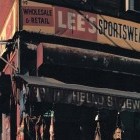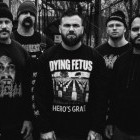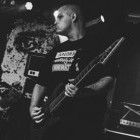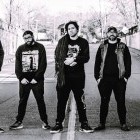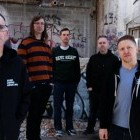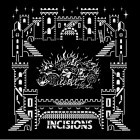
When I first got into hardcore back in the late '80s, I remember thinking to myself, "Who the fuck is Don Fury!?" It seemed like every other release from that world that you looked at featured the guy's name listed in the liner credits. Out of a tiny basement recording studio in a pre-gentrified lower Manhattan, the Long Island native worked on seminal hardcore records from the likes of Agnostic Front, Judge, Gorilla Biscuits, and many more—changing the course of underground punk music in the process.
Like Larry Smith for hip-hop, and Rodger Bain for heavy metal, Fury helped lay down the sonic model for hardcore. In other words, his importance to hardcore cannot be overstated.
In this exclusive interview, I chat with Fury about his career behind the boards and his current projects. One piece of trivia that I learned during our chat that I didn't include in the piece below blew my mind. It turns out, while he had a manager in the '90s, Fury was once presented to produce the Japanese hard rock band Loudness (it didn't end up panning out). Crazy, huh?
At what point did you start using the name "Don Fury," and what was the inspiration behind it?
I've gotta laugh about that! I had a band named The Splits when I first got to NYC, and I think we had seven drummers in our first year! I was the guitarist, vocalist, songwriter, booked the shows, arranged the transportation, and owned the rehearsal studio. Finally, I decided I would just front the band. I took my great-uncle's first name, Fiore, 'cause it sounded like "Fury." My ex convinced me to spell it "Fury," and later when that name started showing up on the back of records I was recording, that was that, I couldn't change it if I wanted. But it was "Donny" in the beginning, and it was Vinnie Stigma that started calling me "Don Fury," like Don Corleone, and it stuck like glue.
I know you got your start in the early '70s playing in local cover bands on Long Island doing hard rock stuff. I've read a lot about the Island back then with bands like The Good Rats packing clubs. What was your experience like?
I was playing lead guitar in high school, and later ended up on bass in a Long Island club band called Rachel that was already past their prime. We played the Tri-state area for awhile, but it wasn't much fun. After I got to NYC, I fronted my own bands on guitar and vocals, played bass in two more, and it was definitely amazing.
You've talked about going into Manhattan around 1977 and seeing the original lineup of The Heartbreakers with Richard Hell at CBGB and being blown away. What is it about the music that drew you in so deeply?
Not just the music—driving into New York City in '77 was like entering another dimension. It was outrageous, daring, dangerous, cinematic, post-apocalyptic. City blocks reduced to rubble. Like a graphic novel. The music was the same. After seeing The Heartbreakers that night at CBGB there was no going back to cover bands in the suburbs. In January '79 I opened my rehearsal studio, Roach, on 17th Street in Manhattan, and Richard Hell and the Voidoids were my second client. Cool.
Sam Phillips' Sun Studios served as the inspiration behind your second studio on 18 Spring Street. That's a great call since many influential hardcore and punk bands got their start recording with you at that studio. One of those recordings was Agnostic Front's United Blood EP. Was Vinnie Stigma as much of a character then as he is now?
Stigma was always a broad character, and a little more so now maybe. I have much respect for Stigma. In my opinion, he's the prototype hardcore guitarist. He's the godfather of NYHC. It is so amazing what all the bands did—starting with Agnostic Front, and a few others—at the Spring Street studio.
How did you become involved with hardcore in the first place?
It was Agnostic Front, Stigma, and me. I walked into an afternoon show at Great Gildersleeves on the Bowery, a couple blocks up from CBGB, just by chance, and Agnostic Front was onstage. It was '82 or '83. I had never seen anything like that show. There were only about 20 or 30 skinny kids moshing and getting nosebleeds. Agnostic Front was fierce. I stayed for the whole set and made sure to meet Stigma after and told him about the studio. Not long after, Agnostic Front came in and recorded United Blood on four-track. That was the beginning.
Did you find it difficult to record so many musicians who hadn't had any formal training when you first started out? If not, what were the challenges you faced during those earlier sessions?
I didn't have any training either. I had recorded my band, and lots of bands doing cassettes at the Spring Street studio, and that was enough to get started. I had a passion for the hardcore style, and respect for the bands, and that was important. Hardcore was disrespected by the music industry then, but we made groundbreaking records and changed the world, and it was totally crucial.
SEE ALSO: 12 Newer Hardcore Bands to Check Out in 2016
The CBGB hardcore matinee was your suggestion to Hilly Kristal, CBGB's owner. How did Hilly react to the slamming and all the other wild crowd reactions happening during the hardcore sets in his club?
In the beginning, the crowds were tiny. Maybe 30 - 40 very young kids—all ages shows. It took a while for the matinee to become a monster show. When that happened, there were lines around the block, and sometimes two shows a day. Inside was a sweatbox jammed with kids standing on anything they could to see, and the pit was amazing. There were fights, beatdowns, and other occasional violence that Hilly had to put security on to try and control. There were times when booking the matinee was suspended for a while because of the mayhem. Mostly, though, I think Hilly had a great appreciation for all the bands and the hardcore scene.
You worked on some pivotal records from the first wave of straight edge hardcore. What were your impressions of that movement?
I thought straight edge was an evolution in hardcore style, and a step forward, and at the same time true to the roots of hardcore. The production was a little more clean, a little more melodic. The bands were dedicated and motivated. In the beginning straight edge was a personal choice, a good one, I thought, not a fashion.
Thinking back to the straight edge era, who were some of the musicians from that scene that you feel were the most gifted in terms of musicianship and/or songwriting?
Sammy Siegler on drums; Porcell on guitar; Ray Cappo, Mike Judge, and Civ on vocals; and Walter Schreifels on just about everything. Walter and I did so many projects together: Gorilla Biscuits, Moondog, the first bands on Walt's Crisis label with Revelation Records, Quicksand, CIV, and World's Fastest Car. By the time we were working on the Manic Compression LP with Quicksand, we hardly needed to speak, we were automatic.
What do you remember about working with Citizens Arrest in 1990? The A Light in the Darkness EP you recorded is so good. You would later connect with vocalist Daryl Kahan again when you worked with Funebrarum.
Daryl was a natural. Some vocalists need to work very hard in the studio, and there's nothing wrong with that, but some like Daryl can just lay it down. Citizens Arrest and the bands in the ABC No Rio scene were raw, brutal, and an important part of hardcore punk in NYC.
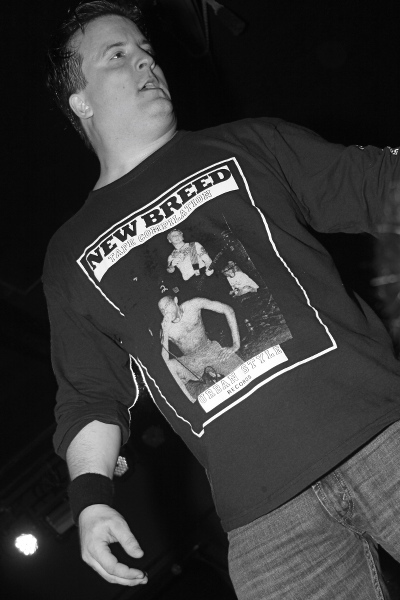
Working with bands like Judge, Gorilla Biscuits, and Youth of Today, you have been an integral part of Revelation Records' rich history. When Jordan Cooper moved the company out to California, do you think it had a negative impact on the NYHC scene? Do you think any local labels stepped up to the plate in Revelation's absence?
It's hard to prove a negative, but I think if Revelation had stayed on the east coast there might have been a good number of classic records made. Once Rev had moved, Wreck-Age stepped up and we did many great records: Mind Over Matter, Yuppicide, SFA, Stillsuit, Madball, Neglect...
In the mid-'90s, you had a deal with TVT Records to have your own imprint called Building Records. Stillsuit's At the Speed of Light album in 1996 was the label's first release.
That was an interesting situation. I originally got their tape from Pavlos [Ioanidis] of Wreck-Age Records. They were originally called Standoff. Now, Pavlos definitely knew how to pick a good band, but a lot of times record label people have a hard time hearing through bad recordings, you know? So, he brought me two recordings that day: Standoff and some nondescript band that had a good recording. The Standoff recording was pretty bad quality, but I liked the songs. I tried to convince him that it was the better band to go for, but he didn't end up going for either one of them. Then I met the Standoff guys and told them that I liked what they were doing and would help them. I also did that with Yuppicide. With that band, I convinced them to come in and let me record them, and then we could find a label to put it out once it was done.
Anyway, Standoff ended up signing with Wreck-Age once I recorded them. They changed their name to Stillsuit before the record came out because there was another band with the name. Stillsuit is actually the band that helped me get the label deal with TVT, but I had to buy them out of their contract with Wreck-Age since I was signed as their producer, but not as their label. Once we did that, they came to Building/TVT.
What do you think of the album now?
I think it's a really good record. Those guys were really stretching on that record [laughs]. But you know what, they were young kids when they recorded that record. Far be it from me to tell them, "Hey, man, hold it back in." They were very ambitious and I let them go as far as they could go and let it out of their system. Either way, it's a great album. It's too bad we couldn't go on and make another one together.
SEE ALSO: 2016 interview with Orlando Arce (Stillsuit, Hello Phones).
How did you land the deal with Building in the first place?
Once I started working with Sandy Roberton [his then manager], a couple of labels had approached him about working with me since my name was out there for recording bands like Quicksand and Orange 9mm. I remember having a meeting with Mercury Records UK. Man, that was weird [laughs]. They wanted to bring me over to England. I was like, "I don't know about this." We had lunch anyway, and we had some kind of offer for like two seconds. But Sandy then approached TVT. I had done my homework on the label's owner [Steve Gottleib] and knew he was a scoundrel before we even went in there for the meeting [laughs]. I pored over the contract and highlighted every term that I didn't understand so that my lawyers could work on it [laughs].
TVT had such a bad reputation. It must have been a nightmare!
Yeah, it was. One of the things in the contract that came back to bite me later was that I wasn't allowed to take an artist that I had offered to TVT and put them on the market. Do you know who that ended up being, later on?
No, who was it?
Glassjaw.
Wow! I had no idea.
I offered Glassjaw to TVT three different times and got turned down. I told them that they were nuts and should trust me since they hired me for a reason. I made like 10 demos with them around 1998 or so. I taught Daryl [Palumbo] how to scream during those sessions. I kept bringing them to the label, practically begging them to sign them. But because of my deal, I couldn't take them to any other labels. Six months later, Ross Robinson signed them to his label, and they were on tour with the Deftones. I was like, "Now do you get it?" But there was nothing I could do about it. I still have those demos. Once every few years, someone approaches me about releasing them, but when I reach out to the band, I get nothing but static [laughs].
Why didn't the TVT imprint deal end up working out?
The label's owner, for God knows what reason, wanted to pull the plug on my deal. He wanted to boot me. I had another six months left on my contract and I asked him to just let me finish that out, since he still owed me. But they said they were done. What they really wanted to do was get rid of me and keep two of the bands I brought in: Stillsuit and Dayinthelife... Stillsuit was a little too avant, and they came out first, so the label bungled it. But Dayinthelife... came out and they were road warriors. I think they played like 200 shows in their first year, or something like that. I feel guilty because I referred to them as "nu-metal," and I was the first person to use that term [laughs]. They did over 10,000 in sales, which was respectable. So, TVT wanted to take the band from under my feet and keep them. The main culprit there was the head A&R at TVT, this guy Sean Roberts. He would be all smiles when we were in meetings together, but then he went and stabbed me in the back.
[Fury ended up suing TVT Records and winning.]
After your studios in Manhattan and Coney Island, Brooklyn, you moved the studio to Troy, in upstate New York, in 2008. What brought on the move and why did you pick Troy?
I chose Troy mostly for my building. It's a very cool former warehouse that was part of the Quandt Brewery Company 100 years ago. Troy is a small satellite city to Albany, the New York state capital. I left my Coney Island studio when development was taking over the area and it looked like I was not going to be able to keep the studio.

What are some of the projects you've worked on lately that you're really excited about?
All the bands at the new studio in Troy are really great. We've had bands traveling to Don Fury Studio from DC, Montreal, NYC, and even Guatemala and Singapore—and I'm very psyched about the mixing and mastering we're doing for world bands. I've done projects at Don Fury Studio from Japan, Italy, Australia, Guatemala, Chile, Poland, Switzerland, Canada, Singapore, and even Turkey. Really cool bands.
SEE ALSO: ABC No Rio Hardcore Matinees 1990 - 1991: A Visual Retrospective
How do bands around the world get to work with you?
They just get in touch, by Facebook or the studio website. It's easy. I really like working with bands from all over the world. If they can't travel to New York I can mix or master their projects and get them a big piece of Don Fury Studio style. I recently worked on a project with hardcore band Overthrown from Singapore. The drums were recorded in Singapore, the guitarist traveled to Don Fury Studio and recorded guitars and bass, the record went back to Singapore for vocals, then came back to Don Fury Studio where I mixed and mastered, and then I sent the finished masters back to Singapore. So the record bounced four times between Don Fury Studio and Singapore. It has the Don Fury Studio style.
What are some of the records and/or bands that appear in your discography that you feel were overlooked?
The Burn EP was immensely influential. It was on Top 10 lists around the world for years, and it was a prototype for post-hardcore, maybe the prototype. Perhaps, because the band didn't follow-up with an LP at that time, or maybe just because they were such a unique prototype, I think the impact of Burn and that EP has been overlooked as time has passed.
If you had to pick one record you worked on from the 18 Spring Street days that best exemplifies hardcore, which one would it be and why?
Of course there isn't just one, and there are too many to mention. Agnostic Front's United Blood EP and Victim in Pain album, Gorilla Biscuits' EP and Start Today album, Sick of it All's We Stand Alone EP, Judge's New York Crew 7", and the Underdog Demos compilation... and that's just a few.
Do you miss NYC?
Sure, I miss NYC back in the day. It was truly epic.
***
Head to Don Fury's official website for more information on how to book time at his studio.
Tagged: don fury

